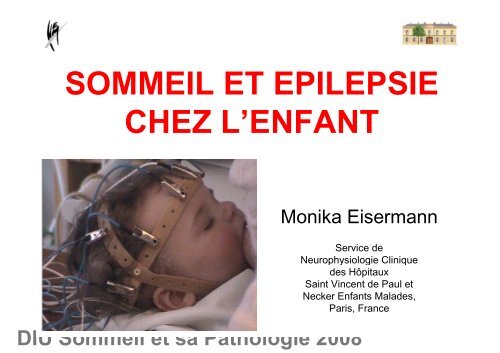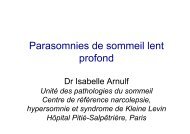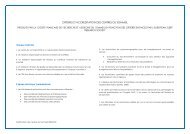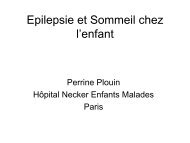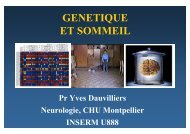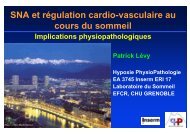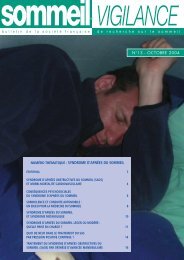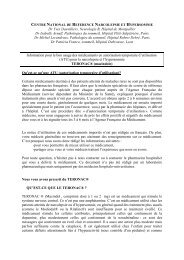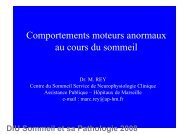DIU Sommeil et sa Pathologie 2008 - SFRMS
DIU Sommeil et sa Pathologie 2008 - SFRMS
DIU Sommeil et sa Pathologie 2008 - SFRMS
Create successful ePaper yourself
Turn your PDF publications into a flip-book with our unique Google optimized e-Paper software.
SOMMEIL ET EPILEPSIECHEZ L’ENFANTMonika EisermannService deNeurophysiologie Cliniquedes HôpitauxSaint Vincent de Paul <strong>et</strong>Necker Enfants Malades,Paris, France<strong>DIU</strong> <strong>Sommeil</strong> <strong>et</strong> <strong>sa</strong> <strong>Pathologie</strong> <strong>2008</strong>
<strong>Sommeil</strong> <strong>et</strong> Epilepsie• L’épilepsie au coursdu sommeil– Les crises liées ausommeil– Les crises liées auréveil– Le diagnosticdifférentiel entremanifestationsépileptiques ou non• Le sommeil de l’enfantépileptique– Les troubles dusommeil liés à lamaladie épileptique<strong>et</strong>/ou à la pathologiesous-jacente– Les conséquencescognitives de<strong>sa</strong>nomalies EEG aucours du sommeil– Eff<strong>et</strong>s secondaires du<strong>DIU</strong> <strong>Sommeil</strong> <strong>et</strong> <strong>sa</strong> <strong>Pathologie</strong> <strong>2008</strong>
Tracé de sommeil• Toujours spontané• Systématique jusqu’à 4 ans• Sieste programmée• Après privation de sommeil• Evtl. Mélatonine p.o.• Enregistrement compl<strong>et</strong> de sommeil denuit (holter EEG ou polysomnographie)<strong>DIU</strong> <strong>Sommeil</strong> <strong>et</strong> <strong>sa</strong> <strong>Pathologie</strong> <strong>2008</strong>
<strong>Sommeil</strong>: technique• Fonction de ce que l’on cherche– Si on veut étudier l’organi<strong>sa</strong>tion du sommeil• Mouvements oculaires• EMG mentonnier– Si l’on veut enregistrer des phénomènescritiques• EMG approprié• ECG, respiration• Evtl. Vidéo simultanée<strong>DIU</strong> <strong>Sommeil</strong> <strong>et</strong> <strong>sa</strong> <strong>Pathologie</strong> <strong>2008</strong>
Pourquoi un tracé de sommeil• Apprécier l’organi<strong>sa</strong>tion du sommeil• Rechercher des anomalies intercritiquessommeil dépendantes• Enregistrer des phénomènes liés ausommeil dont la nature épileptique n’estpas évidente• Rechercher d’autres types de crises<strong>DIU</strong> <strong>Sommeil</strong> <strong>et</strong> <strong>sa</strong> <strong>Pathologie</strong> <strong>2008</strong>
Quelques exemples• Les anomalies focales des EPCT• La désorgani<strong>sa</strong>tion du sommeil dans lesyndrome des POCS• Les crises frontales liées au sommeil• Les crises liées à l’endormissement ouau réveil• L’association de manifestationsépileptiques ou non dans le sommeil<strong>DIU</strong> <strong>Sommeil</strong> <strong>et</strong> <strong>sa</strong> <strong>Pathologie</strong> <strong>2008</strong>
EPCT ou EPR• Epilepsie à paroxysmes centro-temporaux• ou rolandiques• Épilepsie la plus fréquente chez l’enfant(15-25% des épilepsies en pédiatrie)• Prédisposition génétique; épilepsie bénigne• Absence de déficit neurologique ou mental• Début entre 3 <strong>et</strong> 14 ans (pic à 5-8 ans)• Crises motrices brèves survenant en fin denuit ou au réveil rarement secondairementgénéralisées, peu fréquentes<strong>DIU</strong> <strong>Sommeil</strong> <strong>et</strong> <strong>sa</strong> <strong>Pathologie</strong> <strong>2008</strong>
EPCT ou EPR• Sémiologie des crises– Crises motrices focales: clonieshémifaciales parfois précédées deparesthésies (langue, lèvres,..) souventassociées à une déviation latérale de labouche– Parfois anarthrie ou aphasie– Souvent hyper<strong>sa</strong>livation– Générali<strong>sa</strong>tion secondaire possible<strong>DIU</strong> <strong>Sommeil</strong> <strong>et</strong> <strong>sa</strong> <strong>Pathologie</strong> <strong>2008</strong>
EPCT ou EPR• EEG:– Tracé de fond normal (veille <strong>et</strong> sommeil)– Foyer de pointes d’aspect assez typique,« fonctionnelle », ample, biphasique,activées dans le sommeil• Rémission spontanée (adolescence)• Traitement discutable<strong>DIU</strong> <strong>Sommeil</strong> <strong>et</strong> <strong>sa</strong> <strong>Pathologie</strong> <strong>2008</strong>
EPCT ou EPR - veilleSch .. Sabine 10 ansSVP<strong>DIU</strong> <strong>Sommeil</strong> <strong>et</strong> <strong>sa</strong> <strong>Pathologie</strong> <strong>2008</strong>
EPCT ou EPR - sommeilSch … Sabine, 10 ans<strong>DIU</strong> <strong>Sommeil</strong> <strong>et</strong> <strong>sa</strong> <strong>Pathologie</strong> <strong>2008</strong>SVP
EPCT ou EPRPus…, 10 ans<strong>DIU</strong> <strong>Sommeil</strong> <strong>et</strong> <strong>sa</strong> <strong>Pathologie</strong> <strong>2008</strong>NEM
<strong>DIU</strong> <strong>Sommeil</strong> <strong>et</strong> <strong>sa</strong> <strong>Pathologie</strong> <strong>2008</strong>
BECTS seizure at 7h12LEV…Lara 10 ans NEM<strong>DIU</strong> <strong>Sommeil</strong> <strong>et</strong> <strong>sa</strong> <strong>Pathologie</strong> <strong>2008</strong>
Quelques exemples• Les anomalies focales des EPCT• La désorgani<strong>sa</strong>tion du sommeil dans lesyndrome des POCS• Les crises frontales liées au sommeil• Les crises liées à l’endormissement ouau réveil• L’association de manifestationsépileptiques ou non dans le sommeil<strong>DIU</strong> <strong>Sommeil</strong> <strong>et</strong> <strong>sa</strong> <strong>Pathologie</strong> <strong>2008</strong>
ESES CSWS POCS• ESES: Electrical Status Epilepticus during SlowSleep. Patry, Tassinari 1971• CSWS: Continous Spike Waves in Sleep• POCS: Pointes Ondes Continues du <strong>Sommeil</strong>• 6 enfants présentant des PO > 85% du temps desommeil lent, c<strong>et</strong>te activité disparais<strong>sa</strong>nt en SP• R<strong>et</strong>ard mental, troubles cognitifs majeurs• Crises de sémiologie variable, généralisées oupartielles, jamais toniques• Rémission spontanée ou > traitement de<strong>sa</strong>nomalies EEG <strong>et</strong> des séquelles cognitives<strong>DIU</strong> <strong>Sommeil</strong> <strong>et</strong> <strong>sa</strong> <strong>Pathologie</strong> <strong>2008</strong>
ESES CSWS POCSS S S S S16h- 0h 0H - 8HBER..Sonia 7 ans<strong>DIU</strong> <strong>Sommeil</strong> <strong>et</strong> <strong>sa</strong> <strong>Pathologie</strong> <strong>2008</strong>SVP
POCS siesteLAN… Gabriel 5 ans NEM<strong>DIU</strong> <strong>Sommeil</strong> <strong>et</strong> <strong>sa</strong> <strong>Pathologie</strong> <strong>2008</strong>
POCS sommeil lentLAN… Gabriel 5 ans NEM<strong>DIU</strong> <strong>Sommeil</strong> <strong>et</strong> <strong>sa</strong> <strong>Pathologie</strong> <strong>2008</strong>
POCS <strong>et</strong> troubles neuropsychologiques• Association étroite dans le temps POCS<strong>et</strong> dégradation neuropsychologique• Parallélisme entre la durée des POCS<strong>et</strong> l’évolution finale neuropsychologique• Association stricte entre patternneuropsychologique <strong>et</strong> la locali<strong>sa</strong>tion dufoyer intercritique<strong>DIU</strong> <strong>Sommeil</strong> <strong>et</strong> <strong>sa</strong> <strong>Pathologie</strong> <strong>2008</strong>
Pointe Ondes Continues du <strong>Sommeil</strong>Epi PartFonctOccTempCentFront> 85%OccEpi PartSymptoTempCent<strong>DIU</strong> <strong>Sommeil</strong> <strong>et</strong> <strong>sa</strong> <strong>Pathologie</strong> <strong>2008</strong>Front
Syndrome de Landau Kleffner, 1957• Aphasie épilepsie acquise: 248 cas rapportés• Aphasie progressive entre 5 <strong>et</strong> 7 ans• Hyperkinésie <strong>et</strong> troubles de la personnalité• Crises dans 70 à 80 % des cas (1 seule crise dans30% des cas)• P <strong>et</strong> PO temporales (50% des cas) veille• Activation au sommeil +++• Benzo, corticothérapie, transsection sous piale<strong>DIU</strong> <strong>Sommeil</strong> <strong>et</strong> <strong>sa</strong> <strong>Pathologie</strong> <strong>2008</strong>
ESES CSWS POCSAABBEnfant de 7 ans, Syndrome de Landau-Kleffner. Pointes temporales gauchesdans la veille (A), activation des pointes dans le sommeil qui diffusent à toutl’hémisphère gauche <strong>et</strong> en temporal droit (B)<strong>DIU</strong> <strong>Sommeil</strong> <strong>et</strong> <strong>sa</strong> <strong>Pathologie</strong> <strong>2008</strong>
Pointe Ondes Continues du <strong>Sommeil</strong>Epi PartFonctOccTempCentFront> 85%OccEpi PartSymptoTempCent<strong>DIU</strong> <strong>Sommeil</strong> <strong>et</strong> <strong>sa</strong> <strong>Pathologie</strong> <strong>2008</strong>Front
Pointe Ondes Continues du <strong>Sommeil</strong>Epi PartFonctOccTempCentFront> 85%OccEpi PartSymptTempCent<strong>DIU</strong> <strong>Sommeil</strong> <strong>et</strong> <strong>sa</strong> <strong>Pathologie</strong> <strong>2008</strong>Front
POCS <strong>et</strong> foyer central• Syndrome operculaire épileptiformeacquis– Dysfonction oro-facio-linguale– Dy<strong>sa</strong>rthrie– Parésie muscles faciaux <strong>et</strong> langue– Crises rolandiques, absences atypiques• Myoclonus négatif• EPCT puis POCS<strong>DIU</strong> <strong>Sommeil</strong> <strong>et</strong> <strong>sa</strong> <strong>Pathologie</strong> <strong>2008</strong>
POLSKI400 V AC, trzy fazy, 16 AWAŻNE! Przed przystąpieniem do podłączania od<strong>et</strong>nij zasilanie. Instalacja elektryczna musi byćuziemiona i wypo<strong>sa</strong>żona w łatwo dostępny wyłącznik wielobiegunowy o odległości między stykami conajmniej 3 mm.Producent nie ponosi odpowiedzialności za szkody powstałe na skutek nieprzestrzegania powyższychinstrukcji.Kabel urządzenia jest odporny na wysokie temperatury. Aby uniknąć zagrożenia, uszkodzony kabelpowinien być wymieniony przez elektryka lub inną uprawnioną osobę.Montaż1. Umieść urządzenie w wyciętym otworze idociśnij je mocno, aby uszczelka dobrzeuszczelniała wszystkie luki.2. Zablokuj cztery klipsy pod spodem w rogachwycięcia.Oszczędność energiiKuchenki indukcyjne podgrzewają produkty spożywcze znacznie szybciej niż inne systemy do gotowania.Ponieważ nagrzewa się tylko naczynie, zużycie energii jest małe, co gwarantuje lepszą wydajnośćurządzenia. Kuchenki indukcyjne zużywają w przybliżeniu o połowę mniej energii niż inne systemy.W związku z tym kuchenki indukcyjne są najtańszym rozwiązaniem w zakresie elektrycznych systemówdo gotowania. Są niemal tak opłacalne jak płyty witroceramiczne.OPISOBSŁUGAWskaźniki kołoweWskazują umieszczenie stref grzejnych.29
Pointe Ondes Continues du <strong>Sommeil</strong>Epi PartFonctOccTempCentFront> 85%OccEpi PartSymptTempCent<strong>DIU</strong> <strong>Sommeil</strong> <strong>et</strong> <strong>sa</strong> <strong>Pathologie</strong> <strong>2008</strong>Front
POCS - veilleepilepsie occipitale symptomatiqueAda..8 ans<strong>DIU</strong> <strong>Sommeil</strong> <strong>et</strong> <strong>sa</strong> <strong>Pathologie</strong> <strong>2008</strong>SVP
POCS – sommeilepilepsie occipitale symptomatiqueAda..8 ans<strong>DIU</strong> <strong>Sommeil</strong> <strong>et</strong> <strong>sa</strong> <strong>Pathologie</strong> <strong>2008</strong>SVP
Hémiplégie cérébrale infantilegauche - endormissement2 minHAM…Camille 6 ans<strong>DIU</strong> <strong>Sommeil</strong> <strong>et</strong> <strong>sa</strong> <strong>Pathologie</strong> <strong>2008</strong>NEM
Hémiplégie cérébrale infantilegauche - endormissementHAM…Camille 6 ans<strong>DIU</strong> <strong>Sommeil</strong> <strong>et</strong> <strong>sa</strong> <strong>Pathologie</strong> <strong>2008</strong>NEM
Quelques exemples• Les anomalies focales des EPCT• La désorgani<strong>sa</strong>tion du sommeil dans lesyndrome des POCS• Les crises frontales liées au sommeil• Les crises liées à l’endormissement ouau réveil• L’association de manifestationsépileptiques ou non dans le sommeil<strong>DIU</strong> <strong>Sommeil</strong> <strong>et</strong> <strong>sa</strong> <strong>Pathologie</strong> <strong>2008</strong>
Les Epilepsies Frontales• l’épilepsie partielle frontale à évolutionfavorable. Beaumanoir <strong>et</strong> al, 1983• l’épilepsie partielle du lobe frontal avec crisesnocturnes. Vigevano <strong>et</strong> al, 1993• l’épilepsie frontale nocturne autosomiquedominante. Scheffer <strong>et</strong> al, 1995• Epilepsies frontales symptomatiques<strong>DIU</strong> <strong>Sommeil</strong> <strong>et</strong> <strong>sa</strong> <strong>Pathologie</strong> <strong>2008</strong>
L’épilepsie partielle frontaleà évolution favorable• début des crises entre 4 <strong>et</strong> 8 ans• sémiologie des crises: déviation de la tête <strong>et</strong>rotation du tronc• EEG intercritique: pointes biphasiques frontalesuni ou bilatérales, majorées par le sommeil,associées à des PO généralisées dans 50% descas• EEG critique: pointes frontales diffu<strong>sa</strong>ntrapidement• ces<strong>sa</strong>tion des crises <strong>et</strong> normali<strong>sa</strong>tion de l’EEG<strong>DIU</strong> <strong>Sommeil</strong> <strong>et</strong> <strong>sa</strong> <strong>Pathologie</strong> <strong>2008</strong>
L’épilepsie partielle frontaleà crises nocturnes• antécédents familiaux d’épilepsie idiopathique dans80% des cas• début des crises entre 6 mois <strong>et</strong> 9 ans• crises courtes: contraction tonique du tronc <strong>et</strong> desmembres, avec posture dystonique, <strong>sa</strong>ns perte deconscience• plusieurs crises par nuit• EEG intercritique: normal ou altéré par des POfrontaux unilatéraux• EEG critique: aplatissement frontal bilatéral• efficacité constante du CBZ<strong>DIU</strong> <strong>Sommeil</strong> <strong>et</strong> <strong>sa</strong> <strong>Pathologie</strong> <strong>2008</strong>
L’épilepsie frontale nocturneautosomique dominante: ADNFLE• <strong>sa</strong>lves de crises de sémiologie frontale• survenue exclusive des crises au cours de la nuit• évidence d’une transmission autosomique dominante• aucune atteinte ni neurologique ni mentale• EEG intercritique: anomalies frontales dans 16% descas• EEG critique: décharge critique évidente dans 4 cassur 10• IRM normale• Caractère stéréotypé <strong>sa</strong>ns aspect de progression• CBZ traitement le plus efficace<strong>DIU</strong> <strong>Sommeil</strong> <strong>et</strong> <strong>sa</strong> <strong>Pathologie</strong> <strong>2008</strong>
L’épilepsie frontale nocturneautosomique dominante: ADNFLE• gène respon<strong>sa</strong>ble localisé sur chromosome 20q, ils’agit de la sous unité alpha 4 du récepteurnicotinique de l’acétyl choline (CHRNA4); ce gèneest exprimé dans toutes les couches du cortex frontal• une mutation du CHRNA4 a été trouvée chez 21individus affectés <strong>et</strong> 4 porteurs obligatoires• le même récepteur est en cause pour les CIFB avecune mutation différente<strong>DIU</strong> <strong>Sommeil</strong> <strong>et</strong> <strong>sa</strong> <strong>Pathologie</strong> <strong>2008</strong>
L’épilepsie frontale nocturneautosomique dominante: ADNFLEVideo crise UNG Charlie<strong>DIU</strong> <strong>Sommeil</strong> <strong>et</strong> <strong>sa</strong> <strong>Pathologie</strong> <strong>2008</strong>
L’épilepsie frontale nocturneautosomique dominante: ADNFLEUNG... Charlie 10 ans<strong>DIU</strong> <strong>Sommeil</strong> <strong>et</strong> <strong>sa</strong> <strong>Pathologie</strong> <strong>2008</strong>NEM
L’épilepsie frontale nocturneautosomique dominante: ADNFLEUNG... Charlie 10 ans<strong>DIU</strong> <strong>Sommeil</strong> <strong>et</strong> <strong>sa</strong> <strong>Pathologie</strong> <strong>2008</strong>NEM
Les épilepsies frontalessymptomatiques chez l’enfant• tumeurs cérébrales; méningiomes; gliomes;tumeurs neuroépithélialesdysembryoplastiques (DNET)• dysplasies corticales focales• sclérose tubéreuse de Bourneville• malformations vasculaires; angiomescaverneux• kystes porencéphaliques• neurocysticercose, tuberculomes<strong>DIU</strong> <strong>Sommeil</strong> <strong>et</strong> <strong>sa</strong> <strong>Pathologie</strong> <strong>2008</strong>
Crise frontale nocturneBernardo Anthony 7 ans<strong>DIU</strong> <strong>Sommeil</strong> <strong>et</strong> <strong>sa</strong> <strong>Pathologie</strong> <strong>2008</strong>
BOI… Jérémy, 12 yrs<strong>DIU</strong> <strong>Sommeil</strong> <strong>et</strong> <strong>sa</strong> <strong>Pathologie</strong> <strong>2008</strong>
Epilepsie frontalecryptogénique - crises nocturnesDEL…Emilie 13 ans<strong>DIU</strong> <strong>Sommeil</strong> <strong>et</strong> <strong>sa</strong> <strong>Pathologie</strong> <strong>2008</strong>NEM
Tuberous sclerosis complex<strong>DIU</strong> <strong>Sommeil</strong> <strong>et</strong> <strong>sa</strong> <strong>Pathologie</strong> <strong>2008</strong>
Sclérose Tubéreuse Bournevillecrise au cours du sommeilABVIN… Ludéric, 14 mois<strong>DIU</strong> <strong>Sommeil</strong> <strong>et</strong> <strong>sa</strong> <strong>Pathologie</strong> <strong>2008</strong>NEM
Dysplasie corticale frontale droiteCynthia<strong>DIU</strong> <strong>Sommeil</strong> <strong>et</strong> <strong>sa</strong> <strong>Pathologie</strong> <strong>2008</strong>
<strong>DIU</strong> <strong>Sommeil</strong> <strong>et</strong> <strong>sa</strong> <strong>Pathologie</strong> <strong>2008</strong>
Right frontal seizure in sleep<strong>DIU</strong> <strong>Sommeil</strong> <strong>et</strong> <strong>sa</strong> <strong>Pathologie</strong> <strong>2008</strong>
Epilepsie frontale intercritiquePIE…Hélion 7 ans NEM crise<strong>DIU</strong> <strong>Sommeil</strong> <strong>et</strong> <strong>sa</strong> <strong>Pathologie</strong> <strong>2008</strong>
Epilepsie frontale crise 1.1PIE…Hélion 7 ans<strong>DIU</strong> <strong>Sommeil</strong> <strong>et</strong> <strong>sa</strong> <strong>Pathologie</strong> <strong>2008</strong>NEM
Epilepsie frontale crise 1.2PIE…Hélion 7 ans<strong>DIU</strong> <strong>Sommeil</strong> <strong>et</strong> <strong>sa</strong> <strong>Pathologie</strong> <strong>2008</strong>NEM
Crise frontaleBer.. 19 ans<strong>DIU</strong> <strong>Sommeil</strong> <strong>et</strong> <strong>sa</strong> <strong>Pathologie</strong> <strong>2008</strong>SVP
Epilepsie Frontale - sommeilBer.. 19 ans<strong>DIU</strong> <strong>Sommeil</strong> <strong>et</strong> <strong>sa</strong> <strong>Pathologie</strong> <strong>2008</strong>SVP


